Kristen sets out to reframe Stax’s place in EDH. She argues that too many cards are pigeon-holed as Stax when they actually have a place in the format.
If you’ve played a game of EDH, you’ve probably encountered the “groan.” While quite often it’ll arise from terrible puns and wordplay (at least at my tables), it’s usually heralded by a particular play or card: Cyclonic Rift; Maze of Ith; Seedborn Muse; Dockside Extortionist. But the most painful groan, in my opinion, is the internal groan you feel when other players groan too much about fair and necessary interaction.
Stax & Tax
Interaction is what makes Magic such a great game. I touched on it recently in my piece about how people should be running more – and expecting more – graveyard hate. When we sit down to play a game of Commander, we’re doing it for the social experience, and for the opportunity to play an interactive game. Not many other games offer such intricate ways for players to respond or anticipate their opponents’ moves, and that’s harder still to find in a multiplayer setting. What we don’t do is sit down to play Solitaire.
On-the-stack interaction isn’t the only form of interaction, and there are large swathes of the player base that seem to feel like it is. Stax and Tax are both forms of proactive interaction, and they provide puzzles and hurdles for other players to solve.
Now, not all game pieces are created equally, and some of the more divisive ones have become the poster children for Stax – and that’s before I even get into how people are more than willing to throw taxing effects under the same bus. Stasis and Winter Orb are perhaps the most recognizable Stax pieces, and it’s easy to see why they’re so reviled.
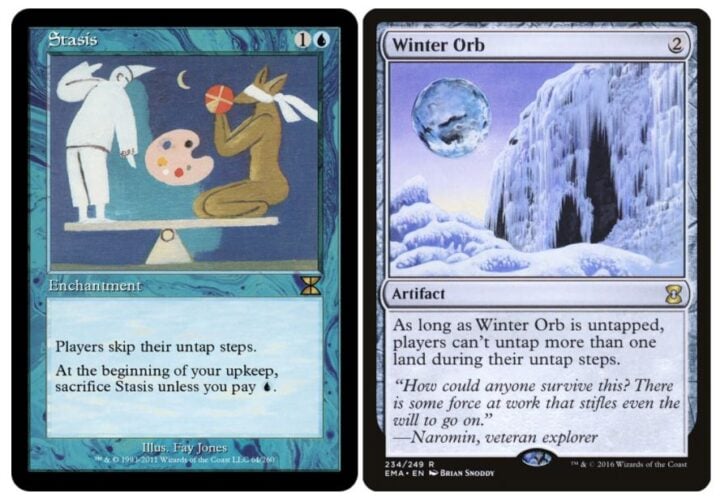
These game pieces don’t just slow down a game; they stop it dead in its tracks. While arguments can be made that Winter Orb can be played around and made one-sided more easily than Stasis, a good proportion of the time, when a player drops a Winter Orb, the game grinds to a halt. Playing these pieces without a solid follow-through is akin to dropping Mass Land Destruction like Armageddon without a way to win. It’s not just terrible from a tactical point of view – it’s also impolite.
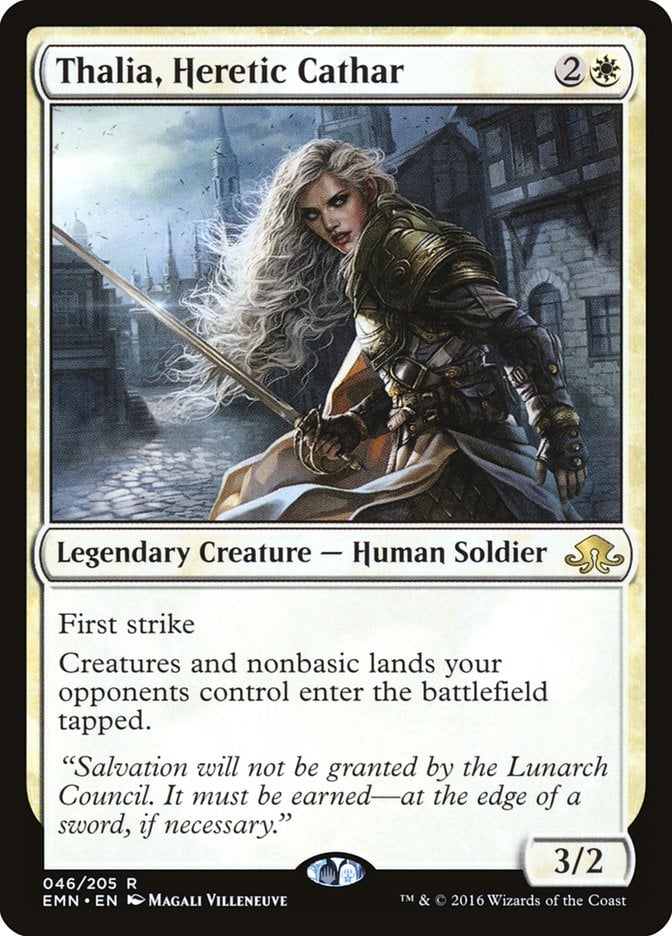
Now, nobody in their right mind would suggest that cards like Thalia, Heretic Cathar or Urabrask the Hidden are in the same league as the above cards, because they’re not. However, there is a certain stigma to running proactive interaction, and too often, players lump everything into the category of “Stax” and declare they just want to play unadulterated Magic.
Defining Stax
While I can certainly empathize with not wanting to sit across from Stasis, I think players are being too sensitive about fair interaction. You can always goldfish a deck on your own at home if that’s what you’re into, but when you sit down at a table? It’s give and take.
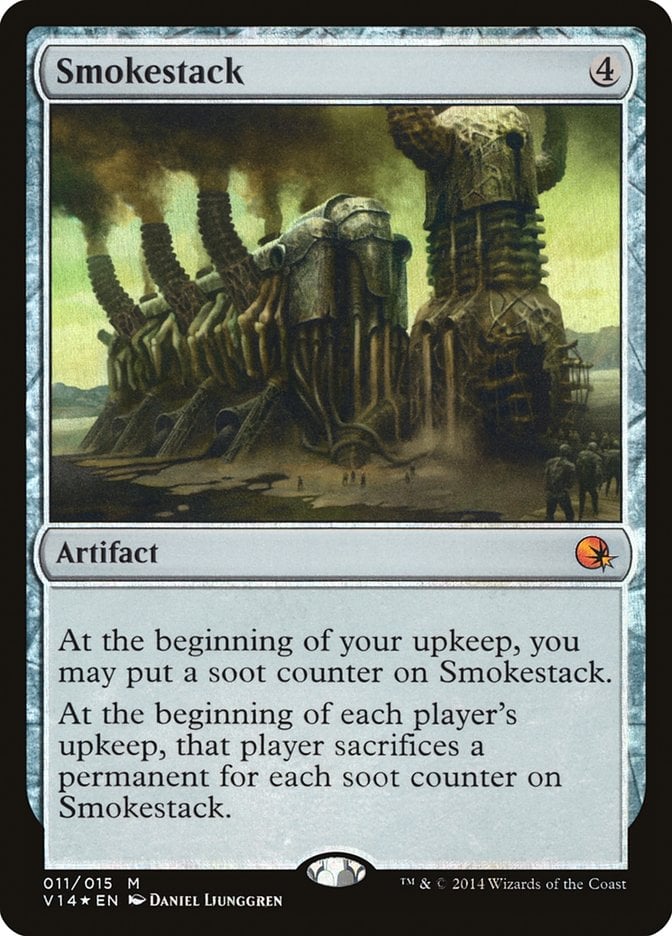
The original coining of Stax owes as much to the use of the card Smokestack as it does to how much the deck costs:
“Stax” is short for “The Four Thousand Dollar Solution” ($T4KS), since the deck originally cost about $4,000 to build. It [is] an archetype that was [originally] created for the Vintage environment to combat a metagame based around doing degenerate things. Stax usually wins very, very slowly through copious amounts of disruption and resource denial.
– MtG Salvation Forum User Adam W
Today, people are a little lazy about what they define as Stax, so I’m going to attempt to delineate how different cards seek to affect the game. Stax decks in EDH are more commonly seen in cEDH, and rarely in casual settings. Their aim is to lock out opponents from playing the game at all, and they do this with permanents that restrict game actions. With this M.O. in mind, I think it’s safe to define Stax pieces as cards that lock one or more players out of a game. (That’s the winning “very, very slowly” part of the original definition.)
While I will not be exhaustive in giving examples here, I do want to frame this definition. Here are some cards that, to me, definitively fall under the Stax banner:
- Stasis
- Winter Orb
- Static Orb
- Rising Waters
- Storm Cauldron
- Smokestack
- Words of Wind
- Back to Basics
- Drannith Magistrate
- Decree of Silence
- The Tabernacle at Pendrell Vale
The cards above are all notorious for stopping a game from happening, either through not allowing lands to untap, making it prohibitive to play creatures (the format’s defining way to play), or by stopping you from playing your Commander (which is the point of the format, whether you like it or not).
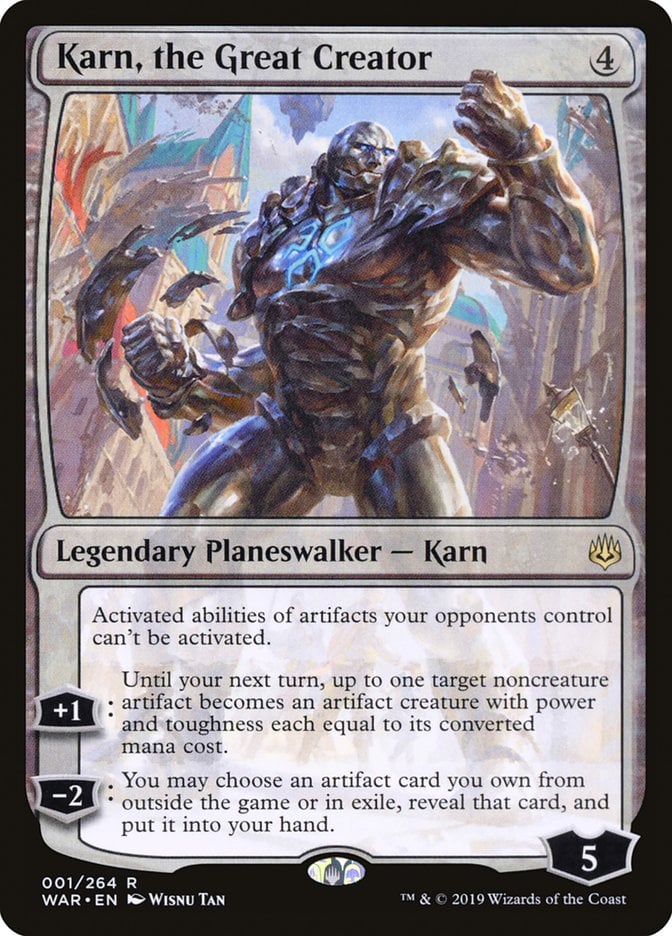
What about Tangle Wire, or Ensnaring Bridge? Karn, the Great Creator? Narset, Parter of Veils? Well, here’s the thing. By themselves, these cards aren’t Stax pieces. They can be solved fairly easily, and, unless combined with the other half of their “combos” (proliferation of counters, Mycosynth Lattice, Wheel of Fortune), don’t have a huge impact on the game for more than a couple of turns. What they do have in common, though, is that they make up the 99 of a Stax deck, and can be oppressive in the right context.
Does that make a deck full of hatebears a Stax deck? Well, the answer is still probably. While I’d argue that a sprinkling of proactive interaction is healthy, it’s definitely a different story when it’s the entire goal of the deck.
Pay the Tax Man
I would argue that Tax effects are not the same as Stax, and it’s due to one key thing: you can still play the game even through multiple Tax pieces, which is not necessarily true when you combine them with Stax pieces.

I’ve recently had people refer to my Liesa, Shroud of Dusk list as Stax, when that couldn’t be further from the truth. Nothing in the deck prohibits players from casting spells, and indeed, I even run Helm of Awakening to encourage players to do so. They just get punished for doing so. Paying extra life to play spells or attack me, or having things come in tapped… nothing in life is free, after all.
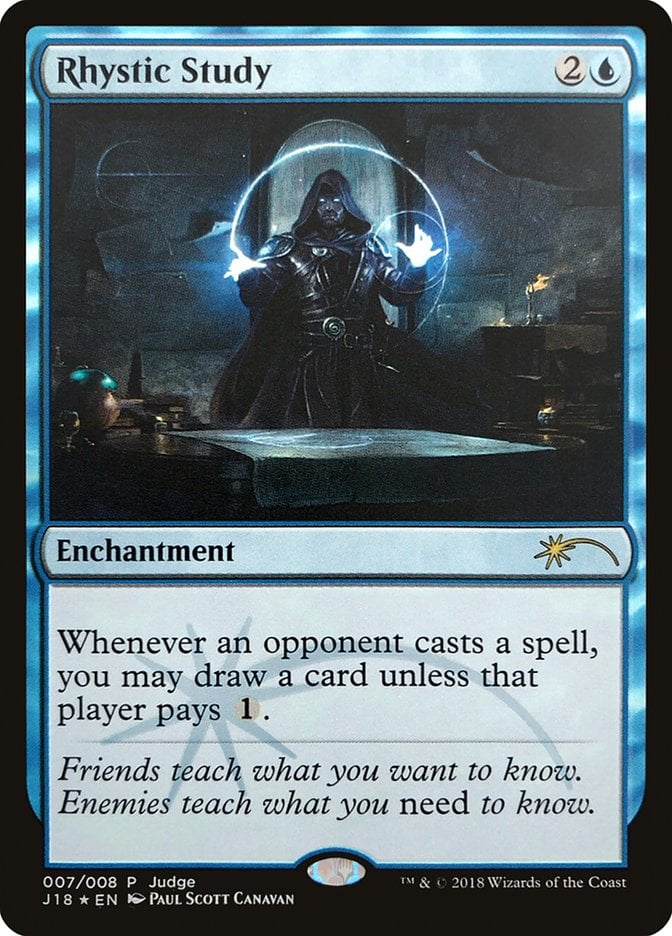
Nobody sees Rhystic Study as a Stax piece. It’s a card draw engine. By that merit, Esper Sentinel isn’t Stax, either. And while we’re on the topic of paying the one? Thalia, Guardian of Thraben also isn’t Stax. While hatebears might be frustrating – whether they stop you drawing more cards or playing multiple spells; or they make you pay a little more mana, or make your creatures come in tapped – they don’t stop you from playing the game. It’s time to refine your definition of Stax.
A few other things that are definitely not Stax:
- Using a Mass Land Destruction spell like Catastrophe to close a game when you can make it one-sided or have an overwhelming board presence
- Playing a Smothering Tithe, or even Wheeling over one. It’s the Boros ritual, let them have it.
- Playing an Aura of Silence or Austere Command that hoses an Artifact or Enchantress deck more than the other decks at the table. Sure, it’s bad beats, but all archetypes get punished in different ways.
- Casting Cyclonic Rift.
- Cards like Blind Obedience, Authority of the Consuls and Ghostly Prison.
- Playing a Fog.
As with hatebears, doing these things in moderation is perfectly fine. You might begin to frustrate other fair decks by looping a Spore Frog or Cyclonic Rift, though, as it does the same thing as hard Stax: stops people playing the game.
Stop Hatin’ the Bears, Hate the Game
Why do hatebears receive so much hate outside of cEDH? It’s a question I often muse on, and I think it’s because people would rather moan about things outside of their control than make an effort to enact change. While that’s also an observation about society – and social media – at large, I think it’s super relevant to how people approach the format.
Too many players have subscribed, whole hog, to the more Solitaire approach to gameplay. This approach is itself symptomatic of the overall power creep of the format, with average game lengths shortening. Taking turns off to play table cop can be a huge tempo loss; it makes sense to drop redundancy, recursion, and toolbox effects, and instead frontload explosiveness. It’s the reason I’ve been entertaining running Temple of the False God in some decks with more expensive commanders again. Better to be lucky than good, after all.
The thing is, if a deck is so weak to a static effect that it’s completely invalidated… Well, that’s just lazy deck building. A great example is Hushbringer, and the adjacent Torpor Orb/Hushwing Gryff/Strict Proctor package. Creatures and artifacts are among the easiest permanents to remove, and if all of your removal is on ETB creatures, then you’re just weak to that effect. And that’s okay. Combat decks are weak to Fogs and Maze of Ith; graveyard decks are weak to graveyard hate; your Yarok or Panharmonicon deck should be weak to Torpor effects.
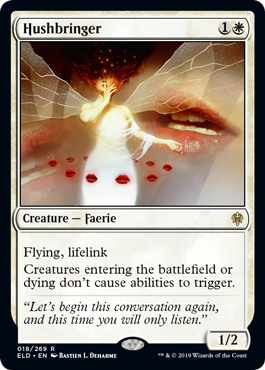
It’s not like you’re out of options either like you would be playing against Stax pieces. You can still play your creatures, and you can still attack the player shutting you off. Oftentimes if you attack enough they’ll chump with their hatebear anyway, and your problem is solved. You can’t underestimate, too, how that effect will screw over the other players at the table. It’s going to be three versus one quite often, so make some allies and figure out the puzzle.
Hatebears provide interesting decision points not only during gameplay, but during deckbuilding. You should consider both Reclamation Sage and Cathar Commando, and even Return to Nature or Krosan Grip. It’s the same when considering indestructible tricks, right? You can’t just run Blasphemous Act or Wrath of God; your other wraths should be Evacuation or Toxic Deluge unless you’re happy being blown out.
Prevention is Better than Cure
The line between fringe cEDH and nitro casual is actually rather blurred, and especially so when you consider the cards that are common between decks. I’ve been diversifying my intake of content recently to keep up with the format, and it’s interesting to see how those lines blur.
As you can see in this video from Portuguese channel Split Second, the Kyodai player wins by flickering Dockside Extortionist with Emiel the Blessed, before using the infinite mana to win the game. This sequence isn’t considered uncouth or too powerful for the high end of the casual meta at all, and commanders like Satoru and Hinata will absolutely be showing up at casual tables as well as cEDH ones. What truly sets these decks apart in power level?
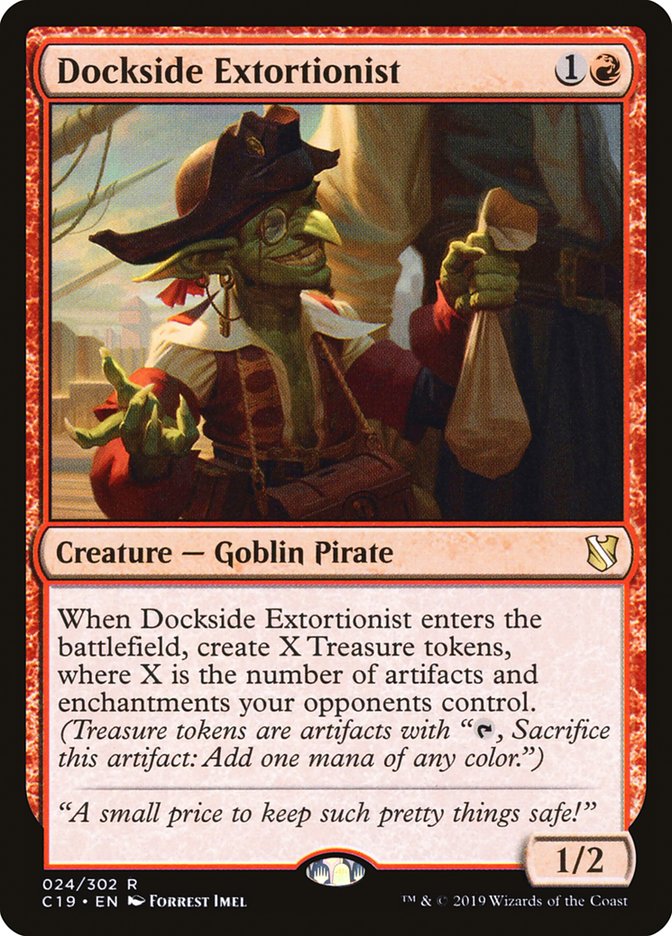
Well, it might be obvious to say free spells and fast mana, but there’s not a huge amount of difference between a cEDH player dropping multiple rocks, and a casual player dropping a Sol Ring and a Jeska’s Will with a Deflecting Swat in hand. The way I see it, nobody should be bullied or groaned at for playing some hatebears or other interaction – “light” Stax – in casual EDH, when people are playing so many best-in-slot cards like Dockside Extortionist, Jeska’s Will, or even Sol Ring-into-Signet starts.
Prevention is better than cure, and though we can’t go back in time to stop Wizards from printing certain cards, we can take that ideology into a game of Commander. Playing hatebears and other taxing effects can act as speed bumps, allowing the pace of a game to relax a little, while offering novel board states and gameplay puzzles to figure out.
What’s more, if people really want to hit that 90-minute goldilocks zone, where players sandbag board wipes toward the end to prevent a game dragging on, but they still want all players to have had a chance to take part in doing their thing and contributing to the game? Hatebears and light Stax are the kinds of speed bumps which allow that kind of game to take place. They stop drag-race starts and allow slower decks to wind up to their bigger plays.
As much as static effects that slow you down can be annoying, they aren’t all automatically Stax. Stax is about stopping a game from taking place, not slowing it down a little. Think of static interaction – which includes hatebears, artifacts, and enchantments with static abilities – as the seasoning to your deck. You might really benefit from them if you’re taking a slower or more fragile strategy, like combat or Voltron, and they might enhance your games if you find your meta has gotten a little too fast. Above all? Let’s all stop knee-jerking at the first sign of interaction. It’ll be okay.

All that remains is to consider how to play against more frequent static interaction. Is the answer to normalize running tutors that allow us to effectively toolbox against roadblocks? Perhaps. Tutors have a similar stigma, and maybe it’s time to examine that, too.
Let me know your thoughts, as ever, on Twitter.

Kristen is Card Kingdom’s Head Writer and a member of the Commander Format Panel. Formerly a competitive Pokémon TCG grinder, she has been playing Magic since Shadows Over Innistrad, which in her opinion, was a great set to start with. When she’s not taking names with Equipment and Aggro strategies in Commander, she loves to play any form of Limited.

